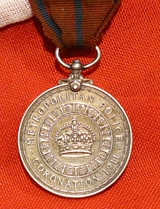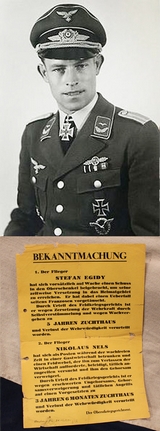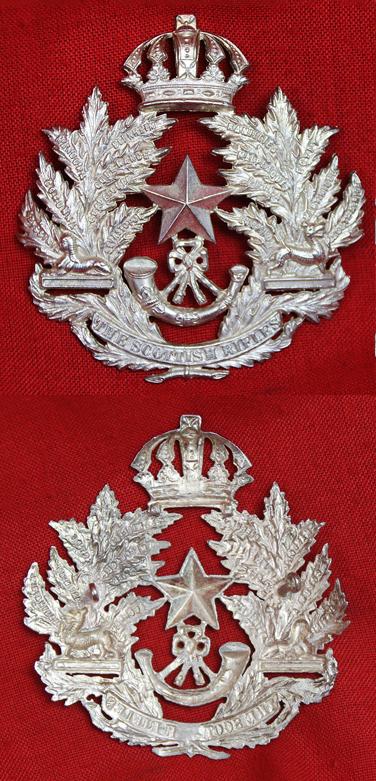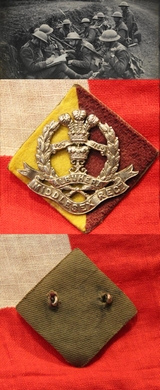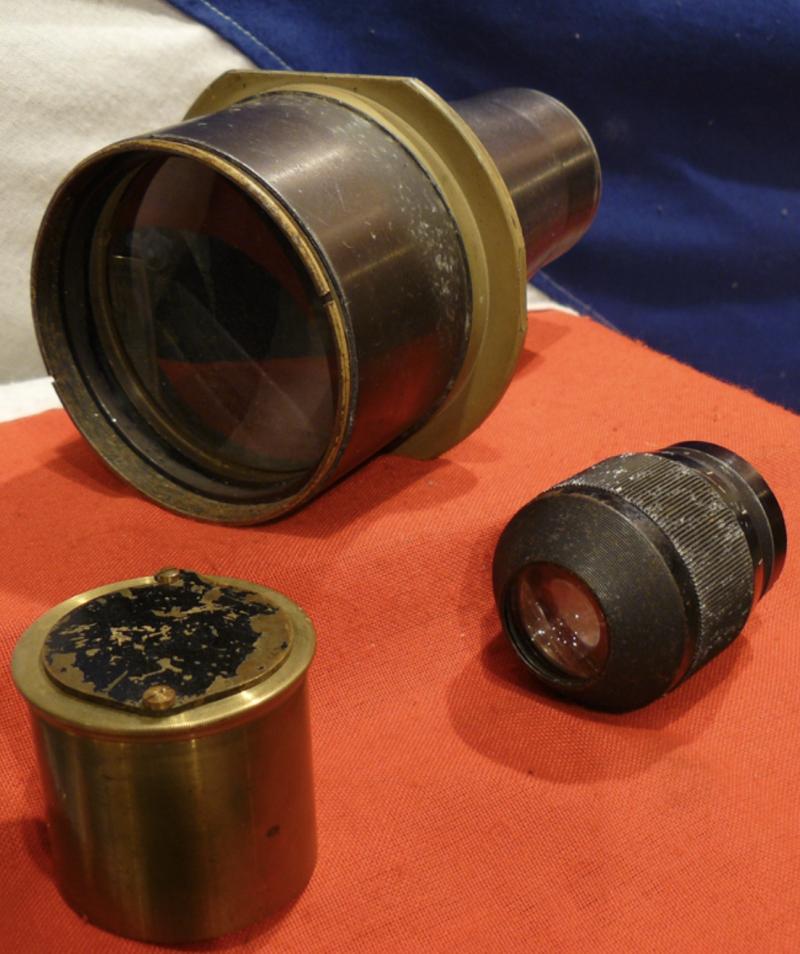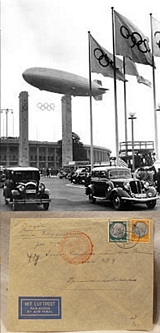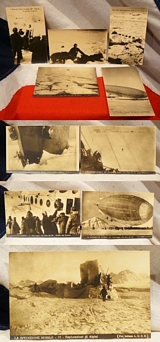WW1 / WW2 / 20th Century
Solid Silver Metropolitan Police Coronation Medal, George Vth 1911
Named to PC Bramble. Very good condition. Original ribbon with silver Spink and Son mount.
The Police Coronation Medal was sanctioned in 1911 as an award to policemen, members of ambulance units, firemen and Royal Parks' staff on duty during the official celebrations of the coronation of King George V that took place during 1911.
The medal is silver and is 1.4 inches (36 mm) in diameter. It was designed by the Australian sculptor Bertram Mackennal.
Obverse: A crowned left-facing bust of King George V with the inscription GEORGIVS V REX ET IND: IMP:.
Reverse: The Imperial Crown with an ornate surround, with the inscription CORONATION 1911 below and the name of the service the recipient was serving with above.
Ribbon: 1.25 inches (32 mm) wide. Red with a narrow central blue stripe, with a similar stripe towards each edge.
The recipient's rank and name were engraved on the edge of the medal read more
60.00 GBP
Fascinating German WW2 Public Notice Poster Regarding Two Luftwaffe Flyers. Public Crucifixion of Former Luftwaffe Fighting Aces. Blamed For The Loss of The Battleship Tirpitz
Der flieger [flyer] Stefan Egidy hat sich vorsatzlich auf wache einen schuss in den oberschenkel beigebracht, um seine zeitweise versetzung in das helmatgeblet zu erreichen .er hat dabel einen ueberfall seitens franzosen vorgetauscht durch urtell des feldkriegsgerichts ist er wegen zerstzung der wehrkraft durch selbstverstummelung und wegen wachvergehen zu 5 jahren zucthaus und verlust der wehrwurdigkeit verurteilt worden. Roughly it translates that Flyer Stefan Egidy was court martialled for a self inflicted wounding and sentence to 5 years and loss of privileges. Also Flieger [flyer] Niklaus Nels was similar court-martialled and sentenced to 3 years 6 months. German pilots were occasionally court-martialled for all manner of reasons, another one at the time was Born in Oberbalbach, Heinrich Ehrler, he grew up in the Weimar Republic and Third Reich as one of 12 children. He joined the military service in the Wehrmacht in 1935, initially service with the artillery and anti-aircraft artillery. He participated in the Spanish Civil War and following the outbreak of World War II transferred to the Jagdwaffe (fighter force). Following flight training, he was posted to the 4. Staffel of Jagdgeschwader 77 (JG 77?77th Fighter Wing), which was later redesignated to 4. Staffel of Jagdgeschwader 5 (JG 5?5th Fighter Wing).
Scapegoated for the loss of the German battleship Tirpitz, Ehrler - who had been nominated for the Knight's Cross of the Iron Cross with Oak Leaves and Swords prior to the disaster - was court-martialled, stripped of his command and sentenced to three years and two months Festungshaft (honorable imprisonment). Ehrler's sentence was later commuted and his loss of rank rescinded, and in February 1945 he was transferred to Jagdgeschwader 7. According to his fellow pilots, Ehrler thereafter flew in the increasingly desperate air battles without the purpose and dedication that had made him one of the Luftwaffe's most successful aces. On 4 April 1945, he shot down two Allied bombers for his final two victories, before destroying a third by ramming with his damaged aircraft after having run out of ammunition. His last recorded statement was "Theo, I have run out of ammunition. I'm going to ram this one. Good bye. We'll see each other in Valhalla." - Heinrich Ehrler's last transmission over the Squadron Radio Network before he rammed the B-24 bomber "Trouble in Mind," piloted by Captain John Ray, destroying both aircraft and killing himself. Central tear through middle can't be seen in photo
Intriguing ephemera from the 3rd Reich would look very fine if framed, obviously not in good condition but as direct examples of WW2 aeronautical history absolutely fascinating. Remarkable to survive and probably unique examples. read more
135.00 GBP
The Scottish Rifles, Helmet Plate, With Battle Honours, Silvered
In jolly nice condition, die cast, two lugs 10cm x 9.5cm.
The Cameronians (Scottish Rifles) was a rifle regiment of the British Army, the only regiment of rifles amongst the Scottish regiments of infantry. It was formed in 1881 under the Childers Reforms by the amalgamation of the 26th Cameronian Regiment and the 90th Perthshire Light Infantry. In 1968, when reductions were required, the regiment chose to be disbanded rather than amalgamated with another regiment, one of only two infantry regiments in the British Army to do so, with the other being the York and Lancaster Regiment. It can trace its roots to that of the Cameronians, later the 26th of Foot, who were raised in 1689. The 1881 amalgamation coincided with the Cameronian's selection to become the new Scottish Rifles.
The regiment's battle honours included:
Early wars: Blenheim, Ramillies, Oudenarde, Malplaquet, South Africa 1846-72, South Africa 1877-8-92, Relief of Ladysmith, South Africa 1899-1902
The Great War: Mons, Le Cateau, Retreat from Mons, Marne 1914 '18, Aisne 1914, La Bassée 1914, Messines 1914, Armentières 1914, Neuve Chapelle, Aubers, Loos, Somme 1916 '18, Albert 1916, Bazentin, Pozières, Flers-Courcelette, Le Transloy, Ancre Heights, Arras 1917 '18, Scarpe 1917 '18, Arleux, Ypres 1917 '18, Pilckem, Langemarck 1917, Menin Road, Polygon Wood, Passchendaele, St Quentin, Rosières, Avre, Lys, Hazebrouck, Bailleul, Kemmel, Scherpenberg, Soissonnais-Ourcq, Drocourt-Quéant, Hindenberg Line, Épéhy, Canal du Nord, St Quentin Canal, Cambrai 1918, Courtrai, Selle, Sambre, France and Flanders 1914-18, Doiran 1917 '18, Macedonia 1915-18, Gallipoli 1915-16, Rumani, Egypt 1916-17, Gaza, El Mughar, Nebi Samwil, Jaffa, Palestine 1917-18
Second World War: Ypres-Comines Canal, Odon, Cheux, Caen, Mont Pincon, Estry, Nederrijn, Best, Scheldt, South Beveland, Walcheren Causeway, Asten, Roer, Rhineland, Reichswald, Moyland, Rhine, Dreierwalde, Bremen, Artlenberg, North-West Europe 1940, '44-45, Landing in Sicily, Simeto Bridgehead, Sicily 1943, Garigliano Crossing, Anzio, Advance to Tiber, Italy 1943-44, Pegu 1942, Paungde, Yenagyaung 1942, Chindits 1944, Burma 1942 '44.
Silver coloured metal, not hallmarked read more
95.00 GBP
Royal Gurkha Rifles, Pouch Belt Badge & Plate - Silver Plate "Come and fight a Gurkha!" Gurkha Lachhiman Gurung VC Who Single Handedly Fought Off & Beat 200 Japanese With One Hand Blown Off & Blinded in 1 Eye By Grenade
Considered to be one of the greatest and bravest regiments in the world. The very finest men to fight alongside, and the very, very worst to fight against.
"Ayo Gorkali" the battle cry of the Gurkhas, "The Gurkhas Are Coming", has been known to instill terror in any confronted enemy of the Gurkhas. Many battle hardened Japanese infantrymen in WW2, and Argentinian soldiers in The Falklands were known to have run and fled or surrendered immediately upon that battle cry being heard.
The Royal Gurkha Rifles (RGR) is a rifle regiment of the British Army, forming part of the Brigade of Gurkhas. Unlike other regiments in the British Army, RGR soldiers are recruited from Nepal, which is neither a dependent territory of the United Kingdom nor a member of the Commonwealth.
Just one example of Gurkha heroism is Corporal Dip Prasad Pun of the 1st battalion (1 RGR) was awarded the Conspicuous Gallantry Cross for an act of bravery during the War in Afghanistan in 2010. He alone defended his outpost against a force of up to 12 Taliban fighters. He fired more than 400 rounds, 17 grenades, and one mine. He resorted to fighting with his machine gun tripod after his ammunition had run out
The battle honours of the Royal Gurkha Rifles are as follows:29
Amboor, Carnatic, Mysore 1792, Assaye 1803, Ava 1852, Burma 1885–87, Bhurtpore, Aliwal, Sobraon, Delhi 1857, Kabul 1879, Afghanistan 1878–80, Kandahar 1880, Tirah, Punjab Frontier, Afghanistan 1919
First World War: La Bassée 1914, Festubert 1914–15, Givenchy 1914, Neuve Chapelle, Aubers, Loos, France and Flanders 1914–15, Egypt 1915, Tigris 1916, Kut al Amara 1917, Baghdad, Mesopotamia 1916–18, Persia 1918, Baluchistan 1918, Helles, Krithia, Suvla, Sari Bair, Gallipoli 1915, Suez Canal, Egypt 1915–16, Khan Baghdadi, Mesopotamia 1916–18, Persia 1916–1918, North West Frontier India 1915–17, Egypt 1915, Megiddo, Sharon, Palestine 1918, Shaiba, Kut al Amara 1915–17, Ctesiphon, Defence of Kut al Amara, Baghdad, Sharqat, Mesopotamia 1915–18
The Second World War: Tobruk 1942, El Alamein, Akarit, Tunis, Cassino 1, Poggio Del Grillo, Gothic Line, Tavoleto, Coriano, Santacangelo, Monte Chicco, Bologna, Medicina, Italy 1944-45, Jitra, Slim River, Sittang 1942, 1945, Kyaukse 1942, 1945, North Arakan, Imphal, Tuitum, Bishenpur, Tengnoupal, Shwebo, Kyaukmyaung Bridgehead, Mandalay, Myinmu Bridgehead, Fort Dufferin, Meiktila, Irrawaddy, Rangoon Road, Chindits 1943,44 & 45, Tamandu, Maymyo
Falklands War.
Picture 8 in the gallery is of Jemadar Jangia Bullets Thapa, 5th Gurkha Regiment, 1890
One of Major-General Frederick Roberts's orderlies during the 2nd Afghan War (1878-1880), Jemadar Jangia Thapa was nicknamed 'Bullets' because regimental tradition had it that he had once been hit on the forehead by a bullet which had been completely flattened without causing him the least discomfort. Thapa was admitted to the Second Class of the Order of British India in April 1897 and was selected as one of the representatives for India at the inauguration of the Australian Commonwealth in January 1901.
One of the most famous Gurkhas in the British Army
Lachhiman Gurung VC ( 30 December 1917 – 12 December 2010) was a Nepalese–British Gurkha recipient of the Victoria Cross, the highest and most prestigious award for gallantry in the face of the enemy that can be awarded to British and Commonwealth forces. He is best known as the "Gurkha who took on 200 soldiers with only one hand" because of his actions in World War II.
On 12/13 May 1945 at Taungdaw, Burma now Myanmar, Rifleman Lachhiman Gurung was manning the most forward post of his platoon which bore the brunt of an attack by at least 200 of the Japanese enemy. He hurled back two hand grenades which had fallen on his trench, but the third exploded in his right hand after he attempted to throw it back, blowing off his fingers, shattering his arm and severely wounding him in the face, body and right leg. His two comrades were also badly wounded but the rifleman, now alone and disregarding his wounds, loaded and fired his rifle with his left hand for four hours (all while he screamed "Come and fight a Gurkha!"), calmly waiting for each attack which he met with fire at point blank range.
His citation in the London Gazette ends with...
...Of the 87 enemy dead counted in the immediate vicinity of the Company locality, 31 lay in front of this Rifleman's section, the key to the whole position. Had the enemy succeeded in over-running and occupying Rifleman Lachhiman Gurung's trench, the whole of the reverse slope position would have been completely dominated and turned.
This Rifleman, by his magnificent example, so inspired his comrades to resist the enemy to the last, that, although surrounded and cut off for three days and two nights, they held and smashed every attack.
His outstanding gallantry and extreme devotion to duty, in the face of almost overwhelming odds, were the main factors in the defeat of the enemy.1
He received his Victoria Cross from the Viceroy of India, Field Marshal Lord Wavell at the Red Fort in Delhi on 19 December 1945
Four threaded mounting screw posts, with two affixing rounded nuts present.
93mm x 75mm read more
140.00 GBP
A Most Scarce Third Reich Period Deutche Luftfahrt/DLV Officer's Visor Cap Insignia, German Flyers Associoation
DLV (German Flyers Association). The German Air Sports Association (Deutscher Luftsportverband, or DLV e. V.) was an organisation set up by the Nazi Party in March 1933 to establish a uniform basis for the training of military pilots. Its chairman was Hermann Göring and its vice-chairman Ernst Röhm. Since the Treaty of Versailles officially forbade Germany from building fighter planes of any sort, the German Air Sports Association used gliders to train men still officially civilians for the future Luftwaffe. The first steps towards the Luftwaffe's formation were undertaken just months after Adolf Hitler came to power. Hermann Göring, a World War I ace with 22 victories and the holder of the Orden Pour le Mérite, became National Kommissar for aviation with former Deutsche Luft Hansa director Erhard Milch as his deputy. On 25 March 1933 the German Air Sports Association absorbed all private and national organizations, whilst retaining its 'sports' title. In April 1933 the Reichsluftfahrtministerium (RLM – Reich Air Ministry) was established. The RLM was in charge of development and production of aircraft, and soon afterwards the test site or Erprobungsstelle at Rechlin became its testing ground, a military airfield that had been first established in August 1918. Göring's control over all aspects of aviation became absolute.
The German Air Sports Association was dissolved in 1937 and replaced with the National Socialist Flyers Corps, a corporation under public law and subordinate to Reichsluftfahrtminister Göring. read more
140.00 GBP
WW1 Middlesex Regt. Officer's Silver Cap Badge, With Rare Battalion Battle Patch
The battalion battle patch, is a very rare surviving piece of divisional command identification, here, it is set mounted behind the silver badge, as the colour designation of the regiment, and in WW1 it was often used thus so on the tropical helmet with the helmet badge together, it could also be sown separately on the uniform as a patch, with the silver badge affixed as usual on the cap, and it is very rare to see complete, the patch with its silver officer’s badge.
On the Brodie helmet it would be added as a painted regimental badge for identification.
The 1st Battalion landed at Le Havre, as line of communication troops, in August 1914 for service on the Western Front.
Lieutenant-Colonel John Hamilton Hall (standing directly in front of the Red Cross on the ambulance), the CO of the 1st Battalion, Middlesex Regiment (98th Brigade, 33rd Division), with his officers. Photograph taken during the battalion's rest near Cassel, 25 April 1918.
The 2nd Battalion landed at Le Havre as part of the 23rd Brigade in the 8th Division in November 1914 also for service on the Western Front.[18]
The 3rd Battalion landed at Le Havre aspart of the 85th Brigade in the 28th Division in January 1915 for service on the Western Front before moving to Egypt in October 1915 and to Salonika in December 1915.
The 4th Battalion land at Boulogne-sur-Mer as part of the 8th Brigade in 3rd Division in August 1914 for service on the Western Front. Some 400 men of the 4th Battalion were killed at the Battle of Mons later that month read more
165.00 GBP
A Rare Set of Spare Parts For A German WW2 Panzer Binocular Gun Sight
With excellent lenses.
Ideal for the collector of WW2 German military opticals, perfect as spares or for replacing lost or damaged parts. They would cost many, many times the price we ask to re manufacture, if they could even be replicated today, and may not be needed now, but to save them in case of need one day, would be exceptionally prudent and sound logic.
They could also be perfect for a collector of German WW2 Panzer military equipment at relatively minute cost.
Photo 3 in the gallery shows a complete binocular with the parts we offer in place
The beauty of these parts is that they are universal fit, even though they came from a panzer case originally they would fit kriegsmarine gun sights and luftwaffe anti aircraft sights read more
175.00 GBP
A Zeppelin Airship Post Letter, For Flight Returning to Berlin for The 1936 Olympics, on the Brazil to Germany Flight, 27 July 1936
A South American Europe Flight, the Hindenberg’s 31st flight, arrived back from Rio to Frankfurt flight and flew to arrive above Berlin at the Olympic Stadium on the 1st August the Olympics of 1936. Superb condition envelope and franked stamps.
The Hindenburg Zeppelin flew over the Olympic Arena, on the 1st of August, and the envelope was date stamped just a few days before on the 27th, midway on its journey from Brazil back to Germany, returning in order to fly at the Olympic Games opening ceremony.
The Berlin Games are best remembered for Adolf Hitler’s failed attempt to use them to prove his theories of Aryan racial superiority. As it turned out, the most popular hero of the Games was the African-American sprinter and long jumper Jesse Owens, who won four gold medals in the 100m, 200m, 4x100m relay and long jump.
Television Coverage
The 1936 Games were the first to be broadcast on television. Twenty-five television viewing rooms were set up in the Greater Berlin area, allowing the locals to follow the Games free of charge.
Young Olympians
Thirteen-year-old Marjorie Gestring of the U.S. won the gold medal in springboard diving. She remains the youngest female gold medallist in the history of the Summer Olympic Games. Twelve-year-old Inge Sorensen of Denmark earned a bronze medal in the 200m breaststroke, making her the youngest medallist ever in an individual event.
Debuts and Firsts
Basketball, canoeing and field handball all made their first appearances
The Hindenburg made 17 round trips across the Atlantic in 1936, its first and only full year of service, with ten trips to the United States and seven to Brazil. In July 1936 it completed a record Atlantic double crossing in five days, 19 hours and 51 minutes. Among the famous passengers was German heavyweight boxing champion Max Schmeling, who returned home on the Hindenburg to a hero's welcome after knocking out Joe Louis in New York on June 19, 1936. During the 1936 season the airship flew 191,583 miles (308,323 km), carried 2,798 passengers, and transported 160 tons of freight and mail, a level of success that encouraged the Luftschiffbau Zeppelin Company to plan the expansion of its airship fleet and transatlantic service.
The airship was reportedly so stable that a pen or pencil could be stood on a table without falling. Its launches were so smooth that passengers often missed them, believing that the airship was still docked to its mooring mast. The cost of one way passage between Germany and the United States was US$400, an especially considerable sum in the Depression era. Hindenburg passengers were generally affluent, including many public figures, entertainers, noted sportsmen, political figures, and leaders of industry.
The Hindenburg was used again for propaganda purposes when it flew over the Olympic Stadium in Berlin on August 1 during the opening ceremonies of the 1936 Summer Olympic Games. Shortly before the arrival of Adolf Hitler to declare the Games open, the airship crossed low over the packed stadium while trailing the Olympic flag on a long weighted line suspended from its gondola.
During 1936 the Hindenburg had a special Bl?thner aluminium grand piano placed on board in the music salon, although the instrument was removed after the first year to save weight. Over the winter of 1936?37, several alterations were made to the airship's structures. The greater lift capacity allowed ten passenger cabins to be added, nine with two beds and one with four beds, thus increasing the total passenger capacity to 72. In addition, "gutters" were installed to collect rain for use as water ballast: taking on rainwater ballast to compensate for the weight of fuel consumed during a voyage was more economical than venting hydrogen.
Another change was the installation of an experimental aircraft hook-on trapeze based on the system similar to the one used on the U.S. Navy Goodyear-Zeppelin built airships Akron and Macon. This was intended to allow customs officials to be flown out to the Hindenburg to process passengers before landing and to retrieve mail from the ship for early delivery. Experimental hook-ons and takeoffs were attempted on March 11 and April 27, 1937, but were not very successful, owing to turbulence around the area where the hook-up trapeze had been mounted. The loss of the ship ended all prospects of further testing. read more
375.00 GBP
A Most Rare Set Of 12 Original Photographs Of The General Nobile 1928 Polar Airship Expedition
Original Polar Expeditions collectables are most highly desirable and we have been delighted to acquire two such connected lots. These are 12 original photographic postcards, published at the time, by two publishers, Traldi and Ballerini & Fratini. For example one is entitled "La Spedizione Nobile - 11 - Esplorazioni di Alpini."
Ed. A. Traldi, Milan, n.d. c. 1928. and another "General Nobile to edge of Italy before leaving."
Umberto Nobile January 21, 1885 ? July 30, 1978) was an Italian aeronautical engineer and Arctic explorer. Nobile was a developer and promoter of semi-rigid airships during the Golden Age of Aviation between the two World Wars. He is primarily remembered for designing and piloting the airship Norge, which may have been the first aircraft to reach the North Pole, and which was indisputably the first to fly across the polar ice cap from Europe to America. Nobile also designed and flew the Italia, a second polar airship; this second expedition ended in a deadly crash and provoked an international rescue effort.The N-class airship Italia was slowly completed and equipped for Polar flight during 1927-28. Part of the difficulty was in raising private funding to cover the costs of the expedition, which finally was financed by the city of Milan; the Italian government limited its direct participation to providing the airship and sending the aging steamer Citt? di Milano as a support vessel to Svalbard, under the command of Giuseppe Romagna.
This time the airship used a German hangar at Stolp en route to Svalbard and the mast at Vads? (Northern Norway). On May 23, 1928, after an outstanding 69 hour long flight to the Siberian group of Arctic islands, the Italia commenced its flight to the North Pole with Nobile as both pilot and expedition leader. On May 24, the ship reached the Pole and had already turned back toward Svalbard when it ran into a storm. On May 25, the Italia crashed onto the pack ice less than 30 kilometres north of Nordaustlandet (Eastern part of Svalbard). Of the 16 men in the crew, ten were thrown onto the ice as the gondola was smashed; the remaining six crewmen were trapped in the buoyant superstructure as it ascended skyward due to loss of the gondola; the fate of the six men was never resolved. One of the ten men on the ice, Pomella, died from the impact; Nobile suffered a broken arm, broken leg, broken rib and head injury; Cecioni suffered two badly broken legs; Malmgren suffered a severe shoulder injury and suspected injury to a kidney; and Zappi had several broken ribs.
The crew managed to salvage several items from the crashed airship gondola, including a radio transceiver, a tent which they later painted red for maximum visibility, and, critically, packages of food and survival equipment which quick-witted engineer Ettore Arduino had managed to throw onto the ice before he and his five companions were carried off to their deaths by the wrecked but still airborne airship envelope and keel. As the days passed, the drifting sea ice took the survivors towards Foyn and Broch islands.
A few days after the crash the Swedish meteorologist Malmgren and Nobile's second and third in command Mariano and Zappi decided to leave the immobile group and march towards land. Malmgren, who was injured, weakened and reportedly still depressed over his meteorological advice that he felt contributed to the crash, asked his two Italian companions to continue without him. These two were picked up several weeks later by the Soviet icebreaker "Krasin". However there were persistent rumors that Malmgren was killed and cannibalized by Zappi and Mariano
They would look incredible suitably bespoke framed [with UV protected glass] read more
675.00 GBP
Greek War Medal 1940-41, Greek Italian War, Battle of Crete
Awarded to Greek and Allied forces that fought agianst the Germans in Crete Battle of Crete 1941 and in Albania, Macedonia, Thrace and Epirus against the Italians.
The Battle of Crete (German: Luftlandeschlacht um Kreta, also Unternehmen Merkur, "Operation Mercury", Greek: Μάχη της Κρήτης) was fought during the Second World War on the Greek island of Crete. It began on the morning of 20 May 1941, when Nazi Germany began an airborne invasion of Crete. Greek and other Allied forces, along with Cretan civilians, defended the island. After only one day of fighting, the Germans had suffered heavy casualties and the Allied troops were confident that they would defeat the invasion. The next day, through communication failures, Allied tactical hesitation, and German offensive operations, Maleme Airfield in western Crete fell, enabling the Germans to land reinforcements and overwhelm the defensive positions on the north of the island. Allied forces withdrew to the south coast. More than half were evacuated by the British Royal Navy and the remainder surrendered or joined the Cretan resistance. The defence of Crete evolved into a costly naval engagement; by the end of the campaign the Royal Navy's eastern Mediterranean strength had been reduced to only two battleships and three cruisers.
The Battle of Crete was the first occasion where Fallschirmjäger (German paratroops) were used en masse, the first mainly airborne invasion in military history, the first time the Allies made significant use of intelligence from decrypted German messages from the Enigma machine,and the first time German troops encountered mass resistance from a civilian population. Due to the number of casualties and the belief that airborne forces no longer had the advantage of surprise, Adolf Hitler became reluctant to authorise further large airborne operations, preferring instead to employ paratroopers as ground troops. In contrast, the Allies were impressed by the potential of paratroopers and started to form airborne-assault and airfield-defence regiments. read more


